Temperature and its Measurement NCERT Solutions | Science for Class 6 PDF Download
Let us enhance our learning
Q1: The normal temperature of a healthy human being is close to .
(i) 98.6 °C
(ii) 37.0 °C
(iii) 32.0 °C
(iv) 27.0 °C
Ans: (ii) 37.0 °C
Q2: 37 °C is the same temperature as .
(i) 97.4 °F
(ii) 97.6 °F
(iii) 98.4 °F
(iv) 98.6 °F
Ans: (iv) 98.6 °F
Q3: Fill in the blanks:
(i) The hotness or coldness of a system is determined by its _______ .
Ans: The hotness or coldness of a system is determined by its temperature.
(ii) The temperature of ice-cold water cannot be measured by a _______ thermometer.
Ans: The temperature of ice-cold water cannot be measured by a clinical thermometer.
(iii) The unit of temperature is degree _______ .
Ans: The unit of temperature is degree Celsius.
Q4: The range of a laboratory thermometer is usually .
(i) 10 °C to 100 °C
(ii) –10 °C to 110 °C
(iii) 32 °C to 45 °C
(iv) 35 °C to 42 °C
Ans: (ii) –10 °C to 110 °C
Q5: Four students used a laboratory thermometer to measure the temperature of water as shown in Fig. 7.6: Fig. 7.6Who do you think followed the correct way for measuring temperature?
Fig. 7.6Who do you think followed the correct way for measuring temperature?
(i) Student 1
(ii) Student 2
(iii) Student 3
(iv) Student 4
Ans: (ii) Student 2
Student 2 is measuring the temperature correctly because the thermometer is fully in the water and not touching the sides or bottom of the container. This way, it only measures the water's temperature.
Q6: Colour to show the red column on the drawings of thermometers (Fig. 7.7) as per the temperatures written below: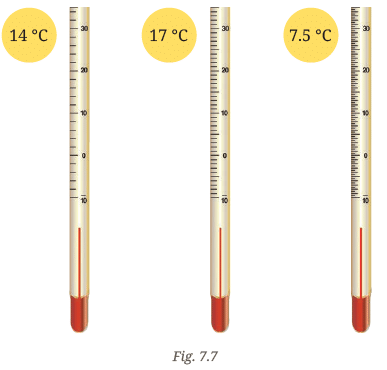 Ans:
Ans: 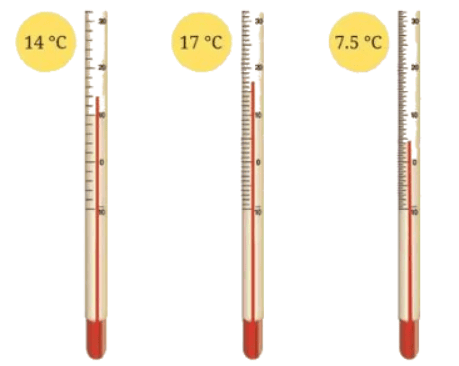
Q7: Observe the part of thermometer shown in Fig. 7.8 and answer the following questions: (i) What type of thermometer is it?
(i) What type of thermometer is it?
(ii) What is the reading of the thermometer?
(iii) What is the smallest value that this thermometer can measure?
Ans:
(i) This is a laboratory thermometer, characterised by its long, narrow tube and a scale that typically ranges beyond the human body temperature range.
(ii) The reading of the thermometer is 26 °C.
(iii) The smallest value that this thermometer can measure is 1°C.
Q8: A laboratory thermometer is not used to measure our body temperature. Give a reason?
Ans: A laboratory thermometer is not used to measure our body temperature because it is designed to measure temperatures over a broader range and must be kept upright, making it inconvenient and potentially unsafe for measuring body temperature.
Q9: Vaishnavi has not gone to school as she is ill. Her mother has kept a record of her body temperature for three days as shown in Table 7.4.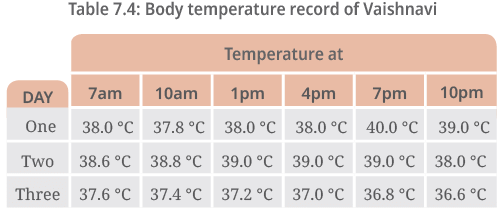 (i) What was Vaishnavi’s highest recorded temperature?
(i) What was Vaishnavi’s highest recorded temperature?
(ii) On which day and at what time was Vaishnavi’s highest temperature recorded?
(iii) On which day did Vaishnavi’s temperature return to normal?
Ans: 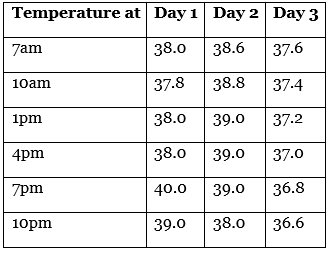
Vaishnavi's body temperature record:
(i) Vaishnavi's highest recorded temperature was 40.0ºC.
(ii) Vaishnavi's highest temperature was recorded on Day One at 7 pm.
(iii) Vaishnavi's temperature returned to normal on Day Three.
Q10: If you have to measure the temperature 22.5 °C, which of the following three thermometers will you use (Fig. 7.9)? Explain.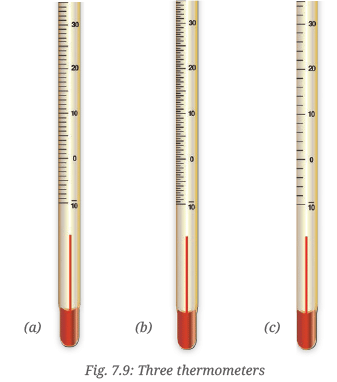 Ans: We will use a thermometer (b)
Ans: We will use a thermometer (b)
Thermometer (a) can measure the smallest value of 1°C and thermometer (c) can measure the smallest value of 2°C as per the small line markings on these.
Only thermometer (b) has the markings on it to measure the smallest value of 0.5°C which is necessary for measuring a temperature of 22.5 °C.
Q11: The temperature shown by the thermometer in Fig. 7.10 is  (i) 28.0 °C
(i) 28.0 °C
(ii) 27.5 °C
(iii) 26.5 °C
(iv) 25.3 °C
Ans: (ii) 27.5 °C
Q12: A laboratory thermometer has 50 divisions between 0 °C and 100 °C. What does each division of this thermometer measure?
Ans: A laboratory thermometer with 50 divisions between 0 °C and 100 °C indicates that each division measures a specific temperature increment. To find the value of each division, follow these steps:
- The total temperature range is 100 °C (from 0 °C to 100 °C).
- Divide the range by the number of divisions: 100 °C / 50 = 2 °C.
Thus, each division on this thermometer represents 2 °C, allowing for measurements to be read in 2 °C increments.
Q13: Draw the scale of a thermometer in which the smallest division reads 0.5 °C. You may draw only the portion between 10 °C and 20 °C.
Ans: 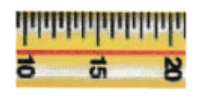 Q14: Someone tells you that she has a fever of 101 degrees. Does she mean it on the Celsius scale or Fahrenheit scale?
Q14: Someone tells you that she has a fever of 101 degrees. Does she mean it on the Celsius scale or Fahrenheit scale?
Ans: She means the temperature on the Fahrenheit scale. Human body temperature does not normally go below 35 °C or above 42 °C. In the Fahrenheit scale, this range is between 95 degrees to 107.8 degrees.
Intext Question
Q1. Can it always be correctly judged, that a person has fever, only by touching the person? (Page 123)
Ans:
- It cannot always be correctly judged that a person has fever, only by touching the person.
- If a person has a normal body temperature and the hand touching that person is cold, the person will feel warmer to the hand. If the hand touching a person is warm, the person with a fever may be felt as at normal temperature.
For correct judgement that a person has a fever or not, we must use a clinical thermometer correctly.
Q2. Do small children generally have slightly higher body temperatures as compared to adults? (Page 128)
Ans: Yes, small children usually have slightly higher body temperatures compared to adults. This is because their bodies are working hard to grow quickly, which makes more heat. For kids, a normal body temperature is usually between 37.0°C and 37.5°C . For adults, it’s a bit lower, usually between 36.1°C and 37.2°C.
Q3. Do old people, even when healthy, generally have lower body temperatures than young adults? (Page 128)
Ans: Yes, even healthy older people generally have lower body temperatures than young adults. As people age, their bodies slow down and don’t produce as much heat. For older adults, normal body temperature is often around 36.2°C to 36.8°C, which is slightly lower than the typical range for younger adults.
Q4: Can a clinical thermometer be used for measuring the temperature of boiling water? Or for measuring the temperature of ice? (Page 129)
Ans: No, a clinical thermometer cannot be used for measuring the temperature of boiling water or ice.
- It is designed to measure body temperature, which ranges from 35°C to 42°C.
- Boiling water (100°C) is too hot and may break the thermometer.
- Ice (0°C) is too cold and outside its range.
- A laboratory thermometer should be used for such measurements.
|
87 videos|376 docs|27 tests
|
FAQs on Temperature and its Measurement NCERT Solutions - Science for Class 6
| 1. What is temperature and how is it measured? |  |
| 2. What are the different scales of temperature measurement? |  |
| 3. What instruments are commonly used to measure temperature? |  |
| 4. How does a liquid-in-glass thermometer work? |  |
| 5. Why is it important to measure temperature accurately? |  |

















